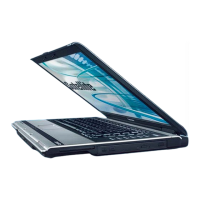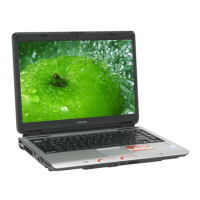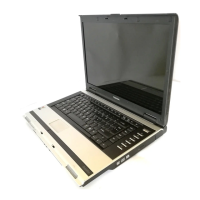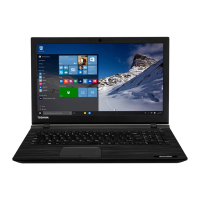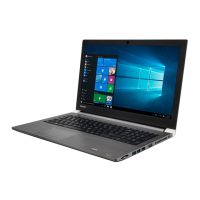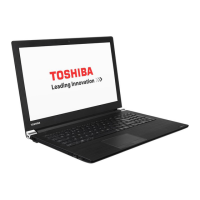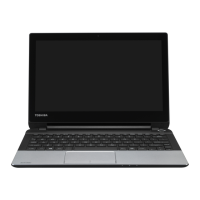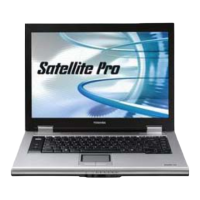
Do you have a question about the Toshiba Satellite Pro A120-106 and is the answer not in the manual?
| Graphics | Intel GMA 950 |
|---|---|
| Operating System | Windows XP Professional |
| RAM | 512 MB DDR2 |
| Display | 15.4 inch |
| Optical Drive | DVD Super Multi Drive |
| Networking | 10/100 Ethernet, 802.11a/b/g Wi-Fi |
| Ports | 3 x USB 2.0, VGA, RJ-45, Microphone, Headphone |
| Processor | Intel Core Duo T2050 |
Guides on setting up an optimal work environment for the computer.
Advises on avoiding heat injury, pressure damage, and other physical risks.
Lists essential hardware items included with the computer.
Lists preinstalled software applications and utilities.
Highlights key features like processor, memory, disks, ports, and slots.
Describes preinstalled utilities and how to launch them.
Lists available optional devices to enhance computer capabilities.
Illustrates and describes the computer's front view when the display is closed.
Details components located on the computer's left side.
Details components located on the computer's right side.
Details ports and indicators on the computer's back side.
Describes components found on the underside of the computer.
Illustrates and describes the computer's front view with the display open.
Explains the status and meaning of various system indicator LEDs.
Describes the indicators related to keyboard states like Caps Lock and numeric mode.
Explains how to connect and use the USB floppy disk drive.
Explains how to use the computer's optical disk drives for media.
Details the AC adaptor's function and connection.
Step-by-step guide on how to connect the AC adaptor for power and charging.
Instructions on how to open the computer's LCD display panel.
Describes turning off the power, standby, and hibernation modes.
Guides on restarting the computer and restoring preinstalled software.
Explains how to use the computer's Touch Pad for navigation.
Explains how to connect, disconnect, and use the USB floppy disk drive.
Explains how to load, remove, and write to optical disk drives.
Offers tips on protecting and cleaning optical and floppy disk media.
Details modem connection, disconnection, and region selection.
Explains Wireless LAN and Bluetooth functions and their indicators.
Guides on connecting and disconnecting to a Local Area Network.
Provides tips on cleaning the computer and using the HDD protection feature.
Describes typewriter keys, function keys, soft keys, and hot keys.
Details the usage of function keys (F1-F12) and Fn key combinations.
Explains hot keys for enabling/disabling computer features like security and display.
Explains keypad overlay functionality, including Arrow and Numeric modes.
Details power conditions, indicators, and battery status.
Covers battery types, care, charging, and extending battery life.
Step-by-step guide for removing and installing the computer's battery pack.
Explains how to set and manage user and supervisor passwords.
Describes computer power-up modes like Boot, Hibernation, and Standby.
Guides on launching and navigating the HW Setup utility.
Details how to customize display settings for internal or external monitors.
Explains how to set the priority for booting the computer from various devices.
Details settings for CPU operating mode and LAN connectivity.
Guides on accessing and exiting the BIOS setup utility.
Discusses Execute-Disable Bit Capability, TPM, and security controller settings.
Lists optional memory cards and expansion options like PC card and SD card.
Lists optional power accessories like battery packs and adaptors.
Lists optional external devices like monitors, drives, and replicators.
Provides instructions for inserting and removing PC cards.
Guides on inserting, removing, formatting, and caring for SD cards.
Details how to install and remove memory modules to increase RAM.
Guides on connecting external monitors, TVs, and i.LINK devices.
Details the features and connections of the Advanced Port Replicator.
Explains how to use a security lock to prevent unauthorized removal.
Provides guidelines for effectively resolving computer problems.
Offers basic checks and analysis steps to identify problem causes.
Addresses problems related to hardware, system startup, and power.
Troubleshoots issues with CD-ROM, DVD-ROM, and floppy disk drives.
Addresses issues with PC cards, Touch Pad, USB mouse, and printers.
Provides guidance on obtaining technical assistance from TOSHIBA.
Details legal footnotes regarding CPU performance variations.
Explains legal footnotes on memory usage and battery life variations.
Clarifies legal footnotes on HDD capacity definitions and LCD characteristics.
Details legal footnotes on GPU performance, Wireless LAN, and non-applicable icons.
Details the computer's weight, size, and environmental operating requirements.
Specifies power requirements and technical details for the built-in modem.
Explains the function of the display controller in interpreting commands.
Lists VGA video modes with resolution, colors, and refresh rates.
Details video modes for WXGA resolution with different processor models.
Lists the technical specifications of the wireless LAN card.
Details radio characteristics and regulatory information for wireless LAN.
Lists supported frequency sub-bands and channels for Wireless LAN.
Describes Bluetooth technology, its interoperability, and health considerations.
Lists regulatory compliance statements for Bluetooth devices in various regions.
Details specifications for AC power cords, including length and wire size.
Lists certification agencies for power cords in various regions.
Lists common abbreviations used throughout the manual.
Defines terms starting with A, B, C, D, E, F.
Defines terms starting with G, H, I.
Defines terms starting with J, K, L.
Defines terms starting with M, N, O.
Defines terms starting with P, Q, R.
Defines terms starting with S, T, U, V.


